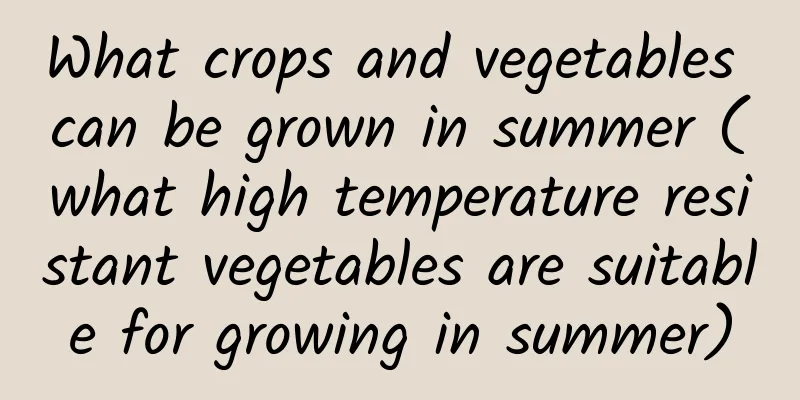What crops and vegetables can be grown in summer (what high temperature resistant vegetables are suitable for growing in summer)

Vegetables suitable for growing in hot weatherWith the change of solar terms, after the summer, the temperature becomes hotter and hotter, and the ground temperature also rises. Cold-sensitive vegetables will grow better at this time. Summer is also accompanied by high humidity and hot weather, and some vegetables cannot adapt to it. What vegetables are suitable to grow in summer? You can have enough vegetables to eat throughout the summer. Let's take a look at these vegetables. 1. CowpeaCowpea is a vegetable crop that likes warmth and is not cold-resistant. Cowpea grows better in hot summer and is also one of the main vegetables in summer. The most suitable growth temperature for cowpea is 20~30 degrees. When it reaches 35 degrees, the beans can still grow normally. Cowpeas will not easily drop flowers and fruits due to the high temperature and high humidity in summer. Cowpeas can still grow well by watering them at night under extremely high temperatures. The ground temperature is relatively high in summer. After planting, the seedlings emerge quickly and evenly, reducing the occurrence of seedling diseases. Cowpeas have strong adaptability, but they are easily damaged by aphids, leafminers, borers, etc. As long as they are controlled in time, cowpeas can solve the problem of eating vegetables throughout the summer. In addition, if management measures are in place, beans can also produce pods for the second time. 2. ChiliChili pepper is the most commonly consumed condiment vegetable, which can be divided into pointed pepper and vegetable pepper. The seedling age period of pepper in winter is about 90 days. Peppers sown in summer do not need to be raised separately, they can be planted directly, and the seedling age is relatively short, about forty to fifty days. During the growth period of peppers, spraying baking soda or vinegar can help prevent pepper diseases. When managing peppers, use less nitrogen fertilizer and mainly use farmyard manure and phosphorus and potassium fertilizers. This will prevent the peppers from growing too tall, and will make them grow healthily and produce more fruits. 3. OkraOkra is a typical tropical vegetable crop, which is heat-resistant but not cold-resistant. Its growing season is mainly distributed throughout summer and autumn. Okra is rich in nutrients and has high nutritional value. It is a high-end vegetable and is favored by consumers. The suitable temperature for okra to grow is 25-30 degrees. With sufficient light, okra will grow well. In summer, okra can be sown directly, and as long as the soil is moist, it will soon sprout. Okra can produce fruit continuously until the frost falls. Okra has strong disease resistance. The only drawback is that it is easily harmed by ants and aphids. With proper prevention and control, you will have endless high-quality okra to eat. 4. Water spinachWater spinach has a very strong ability to withstand high temperatures and can grow very well within the range of 25 to 30 degrees . When the temperature reaches 40 degrees, the leaves grow slowly but will not die. Although the temperature is very high in summer, pay attention to watering at night to cool down. Even if the temperature is higher during the day, it will not hinder the growth of water spinach. Water spinach likes farmyard manure the most. By using less chemical fertilizer and more farmyard manure, you can grow very high-quality water spinach, which can be harvested from the time it is planted until frost occurs. It can be picked for a very long time and can meet the vegetable needs in summer and autumn. As long as you plant a few trees, you can pick them all in one summer. The reason why water spinach can be grown in summer is that it likes a high temperature and humid environment. Water spinach will also grow well in places where there is frequent rain in summer. 5. Sweet potato seedlingsThe tender stems and leaves of sweet potatoes were once known as the "Queen of Vegetables", regardless of how big the underground tubers can grow. The aboveground part of the sweet potato vine can be picked and eaten frequently as a vegetable, and the sweet potato vine has a strong ability to withstand high temperatures . After planting in the summer until the end of the frost, you can pick them continuously, which not only meets the demand for vegetables in the summer, but also provides tubers to harvest in the autumn. |
Recommend
When is the best time to plant Clivia seeds?
Clivia seed planting time Clivia is a perennial p...
When does the Fire Festival bloom?
Fire Festival Blossom Fire Festival is a succulen...
How to grow Japanese lilies and make them bloom more
Growth conditions of chrysanthemum The daylily li...
What does chrysanthemum mean?
1. Meaning 1. Mourning: In my country, chrysanthe...
The difference between Luna Lian and Lina Lian
1. Difference of blades The leaves of Luna Lily a...
Best time to fertilize pear trees in winter
Pear trees are deep-rooted species with strong tr...
How to change the soil of money tree and what is the time and method to change the soil and pot
When will the money string be replaced with soil?...
Potato planting and harvesting time in Shandong
Potato planting time in Shandong Potatoes in Shan...
What are some succulent plants that bloom beautifully?
1. Minas Although the leaves are not particularly...
How to grow cherry trees
1. Breeding environment 1. Potting soil: It is be...
How to save peach seeds
How do peach seeds come from? Peach is a plant of...
What is the reason why the leaves of the money tree have spots and turn yellow?
Many families like to place money trees indoors. ...
The plums are a bit small, what kind of fertilizer is good? (What fertilizer should be applied to the plum tree to make it sweet)
What fertilizer is better for plums? Plum is a co...
Can Kalanchoe be grown in pine needle soil?
1. Pine Needle Soil 1. You cannot pile up pine ne...
How to propagate Magnolia
1. Grafting method (1) Time selection: Generally ...









